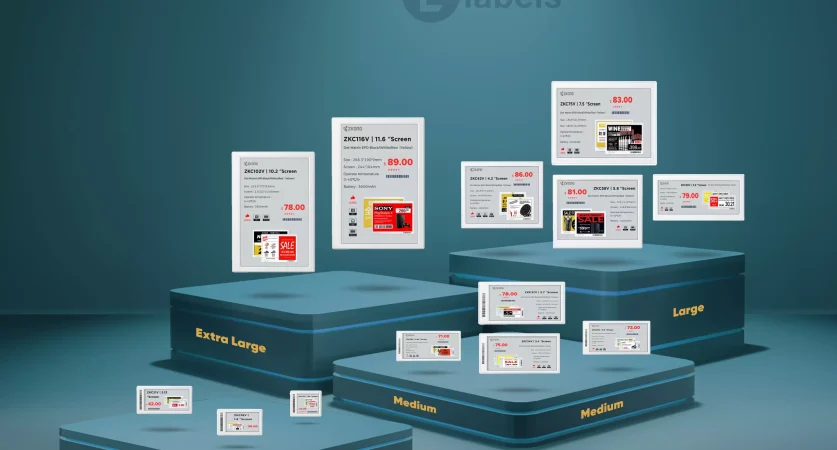Shelf Labels: Enhancing Retail Efficiency and Customer Experience

In the bustling realm of retail, where every square inch of space is a precious commodity and every second counts, the role of shelf labels extends far beyond their apparent simplicity. These unassuming strips of paper or electronic displays hold the power to streamline operations, boost sales, and create an exceptional shopping experience for customers. As the retail landscape continues to evolve, the significance of well-designed shelf labels becomes increasingly pronounced.
At first glance, shelf labels might seem like mundane tools for price display. However, their purpose transcends mere price communication. In fact, they serve as essential navigational aides within the labyrinthine confines of modern retail spaces. Efficient shelf labeling contributes to optimal inventory management, making it easier for employees to locate and restock products, reducing downtime and ensuring products are always available for customers. This results in a more organized store layout, reducing customer frustration and enhancing the overall shopping experience.
In the digital age, traditional paper labels are evolving into electronic displays that offer enhanced functionality. Electronic shelf labels (ESLs) are becoming a game-changer in the retail industry. With the ability to update prices and product information in real-time, ESLs eliminate the need for manual adjustments, reducing human error and improving pricing accuracy. This dynamic pricing capability allows retailers to implement strategies like surge pricing during peak hours or automate markdowns to clear out excess inventory. Consequently, ESLs empower retailers to adapt swiftly to market trends and consumer demand, optimizing revenue while maintaining customer trust.
Personalization has become a hallmark of successful retail operations, and shelf labels are no exception. Advanced technology, such as RFID (Radio-Frequency Identification), enables retailers to gather valuable data on consumer preferences and shopping patterns. By integrating this data with shelf labels, retailers can provide personalized recommendations to customers as they browse the aisles. Imagine a shopper being alerted to a special offer on their favorite brand of cereal as they walk down the aisle. This level of personalized engagement not only increases the likelihood of a purchase but also fosters a deeper connection between the customer and the store.
Moreover, shelf labels play a pivotal role in bridging the gap between the physical and digital realms of retail. Many consumers engage in “showrooming,” where they visit a physical store to examine products before making an online purchase. By incorporating QR codes or NFC (Near Field Communication) tags into shelf labels, retailers can seamlessly connect the in-store experience with online platforms. Scanning these codes with a smartphone allows customers to access additional product details, reviews, and even make a purchase online if the item is out of stock in-store. This integration transforms shelf labels into gateways to a broader shopping ecosystem, catering to diverse consumer preferences.
The significance of clear and accurate pricing cannot be overstated in the retail industry. Price discrepancies between the shelf label and the checkout counter can erode customer trust and lead to dissatisfaction. To counter this, shelf labels equipped with electronic monitoring can help maintain price consistency, reducing the occurrence of such discrepancies. Additionally, these labels can display product-specific information, such as ingredients, nutritional facts, and allergen warnings. For consumers with dietary restrictions or preferences, having easy access to this information at the point of purchase is invaluable.
In conclusion, Electronic Shelf Labeling have evolved from basic price indicators to multifaceted tools that shape the retail landscape. Their impact extends beyond visual aesthetics to operational efficiency, data-driven personalization, and seamless omnichannel integration. Whether in traditional paper form or as cutting-edge electronic displays, shelf labels play a pivotal role in delivering an exceptional shopping experience. As technology continues to advance and consumer expectations evolve, retailers will find themselves relying more heavily on these unassuming yet indispensable elements to thrive in an ever-changing industry.
- SHARES

Ashmawi Sami has a Bachelor degree in Travel and Tourism Management from the University of Minnesota. He has his own travel vlogging channel. Besides being a fantastic yoga instructor he has travelled to 9 countries and planning his next trip soon. As the father of 3 dogs, he is well-trained in parenting, crowd control, and crisis situations.
ABOUT ME

Gillian is a freelance blogger, student, and full-time traveler. Each day she spends her time exploring something exciting to help people find the information they need while travelling to a new destination. Whether it be the place to enjoy holidays, or a spot to throw a party or hidden gems that you must visit in the city.
ALL CATEGORIES
- Adventure (13)
- Automotive (8)
- Business (668)
- Education (13)
- Event (4)
- Health (285)
- Indibet App 740 (1)
- Insurance (11)
- Lifestyle (12)
- News (1)
- Real Estate (19)
- Shopping (26)
- Technology (22)
- Travel (6)

JOIN US TODAY
POPULAR POST
January 27, 2021 -
Adventure Travel For The Audacious Spirit
January 27, 2021 -
Small Business Loans for Women
January 27, 2021 -
Adventure Tours in Vanuatu
RECENT POST
April 23, 2025 -
The various types of Online Casino Bonuses
Casino online, also known casino mit entercash as...
April 23, 2025 -
Gambling Enterprise Online Genuine Cash: A Comprehensive Overview
Invite to our insightful article concerning online casino...
April 23, 2025 -
Casinos that Approve PayPal: A Convenient and Secure Alternative for Online Gamblers
On-line gambling enterprises have revolutionized the means individuals...
April 23, 2025 -
Online Gambling Establishments that Pay Actual Cash PayPal: A Comprehensive Guide
Online casino sites have transformed the method individuals...








